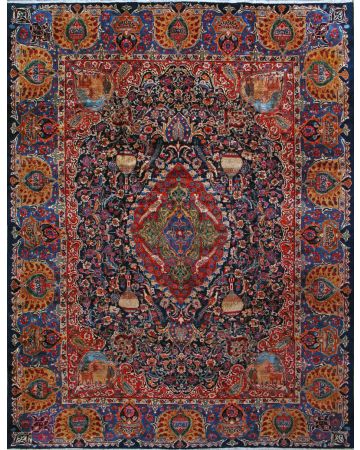From Persia to Your Home - The Journey of a Handmade Rug
When it comes to handmade Persian rugs, they are celebrated for their intricate designs, rich colors, and exceptional craftsmanship. Each rug embodies a unique story, from its creation in the heart of Persia to its arrival in a home, where it often becomes a cherished heirloom. Understanding this journey provides a deeper appreciation for the artistry and effort involved in producing these stunning pieces.
·
Weaving Techniques
Once dyed, the wool or silk is spun into yarns, ready for weaving. Persian rugs are traditionally woven on a loom using a
knotting technique known as the "Persian knot" or "Senneh
knot." This method involves tying individual knots onto the warp threads
(the vertical threads) of the loom. The knots are then sheared to create a
pile, which contributes to the rug’s texture and pattern.
The design of a Persian rug is often a complex and symbolic pattern that
reflects cultural and historical themes. Common motifs include geometric
shapes, floral designs, and medallions, each with its own significance. The
design is usually drawn onto a graph paper template, guiding the weaver through
the intricate process of translating the pattern into the rug.
·
Intertwining the Rug
Weaving a large
oriental rug is an
immensely labor-intensive process. Depending on the rug’s size and complexity,
it can take anywhere from several months to several years to complete. Each
knot is meticulously tied by skilled artisans, who must ensure that the pattern
remains consistent throughout the rug. The weaver’s expertise is crucial, as
the quality of the knots and the precision of the design are essential to the
rug’s overall appearance and durability.
·
Quality Control
Once the weaving is completed, the rug undergoes a thorough quality
check. Inspectors examine the rug for any imperfections in the pattern or
knots. Any necessary repairs are made, and the rug is cleaned and trimmed. The
finishing touches include removing excess fibers, which ensures a smooth and
even surface.
·
The Journey to Your Home
After the rug has passed quality control, it is carefully rolled and
packed for shipment. This phase involves meticulous handling to prevent damage
during transportation. Persian rugs are often shipped in crates or protective
wrapping, ensuring they arrive in pristine condition.
Upon arrival, the rug might undergo a final inspection by the importer
or retailer before being made available to consumers. Many rugs are sold
through specialized dealers like ArmanRugs who have deep knowledge of Persian rugs and
can provide valuable insights into their history and significance.
·
The Rug’s New Home
Once purchased, the rug finds its place in a home, where it often
becomes a centerpiece of decoration and conversation. Its journey from Persia
to the living room reflects not just the skill of the artisans who created it,
but also the rich cultural heritage of Persian rug-making. Each rug carries a
piece of its origin, making it a timeless and treasured artifact in its new
home.
In summary, the journey of handmade Iranian rugs is a testament to the artistry, patience, and tradition of its
creators. From the initial selection of materials to the final placement in a
home, each step in the process underscores the rug’s exceptional quality and
historical significance.


Comments
Post a Comment